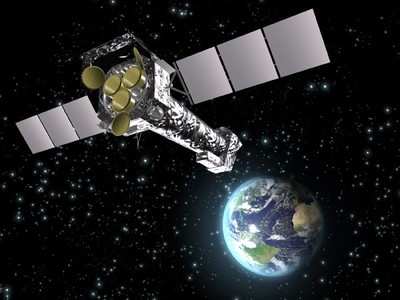XMM-Newton Sending Faintest Of Radio Signals
The European Space Agency reports it lost contact with its
XMM-Newton X-ray observatory last weekend. Many space agencies and
organizations are now joining forces trying to fix the problem...
the second major technical glitch to strike an orbital observatory
in as many months.

As ANN reported, NASA was forced to delay a
scheduled repair mission to the Hubble Space Telescope, after
the failure of the observatory's command and
data-handling system in late September. NASA was finally
able switch on a backup system Thursday, that should
return Hubble to near-full operations.
Things appear even more dire for the XMM-Newton, though there
are signs of life: a feeble radio signal has been heard, and ground
observations confirm that the spacecraft is intact.
XMM-Newton has operated faultlessly in orbit for almost nine
years, close to its 10-year design lifetime. In that time, it has
become a workhorse of modern astronomy ...and so when it is in
trouble, ESA says it is a case of "all hands to the pumps," with
all available resources called to help.
During the evening of October 18, XMM-Newton was approaching the
point of closest approach to Earth, or perigee, along its 48-hour
highly elongated orbit around Earth. At that time, it was
communicating normally with the Santiago ground station in Chile
through one of its two antennas.
After the spacecraft moved out of visibility from Santiago, its
radio signal -- routinely switched to the other antenna by a
previously uploaded command -- was expected to be picked up by
ESA's Villafranca ground station in Spain about an hour later.
Unfortunately, radio contact was never reestablished, despite the
best efforts by the XMM-Newton flight control team at ESA's
European Space Operations Centre (ESOC) in Darmstadt, Germany, as
well as other ESA ground stations.
ESA says the situation hinted at either a technical problem on
board or, in the worst case, a catastrophic event in orbit, such as
a collision with space debris or a meteoroid, or a malfunction of a
thruster making the spacecraft tumble wildly, or even an
explosion.
Luckily, the worst cases have been ruled out as amateur
astronomers in Germany's Starkenburg observatory took images of the
sunlit XMM-Newton against the night sky. This showed that the
satellite has not fragmented and that it is maintaining a constant
attitude in its expected orbit. This was confirmed later by the
many other ground-based telescopes across the globe that answered
XMM-Newton's call for help.
 The
subsequent recovery attempt involved a more powerful ground
station. ESA's 35 m-diameter antenna at New Norcia (Western
Australia), using a radio-science mode developed for deep space
missions, finally detected a weak signal from XMM-Newton, showing
that the spacecraft is alive.
The
subsequent recovery attempt involved a more powerful ground
station. ESA's 35 m-diameter antenna at New Norcia (Western
Australia), using a radio-science mode developed for deep space
missions, finally detected a weak signal from XMM-Newton, showing
that the spacecraft is alive.
Engineers at ESOC, supported by European industry and experts
from other ESA sites, are now trying to command the spacecraft in
the attempt to recover a working configuration for XMM-Newton's
communication system. To get the best chances of success, ESA has
also requested the emergency support of NASA's Deep Space Network
antennas in Canberra (Australia) and Goldstone (USA). Owing to
their favorable locations when the satellite is closest to Earth,
they can direct a more powerful signal to it.
Engineers hope to be able to reestablish nominal ground contact
with XMM-Newton within the next few days. Until then, the
spacecraft and instruments should be safe. In fact, they were
prepared for perigee passage - where the instruments have to be
protected from Earth's glare and the effects of Earth's radiation
belts - when the anomaly occurred.
 Airborne-Flight Training 05.09.24: ERAU at AIAA, LIFT Diamond Buy, Epic A&P
Airborne-Flight Training 05.09.24: ERAU at AIAA, LIFT Diamond Buy, Epic A&P ANN's Daily Aero-Term (05.07.24): Hazardous Weather Information
ANN's Daily Aero-Term (05.07.24): Hazardous Weather Information Aero-News: Quote of the Day (05.07.24)
Aero-News: Quote of the Day (05.07.24) NTSB Final Report: Cessna 150
NTSB Final Report: Cessna 150 Aero-News: Quote of the Day (05.08.24)
Aero-News: Quote of the Day (05.08.24)




